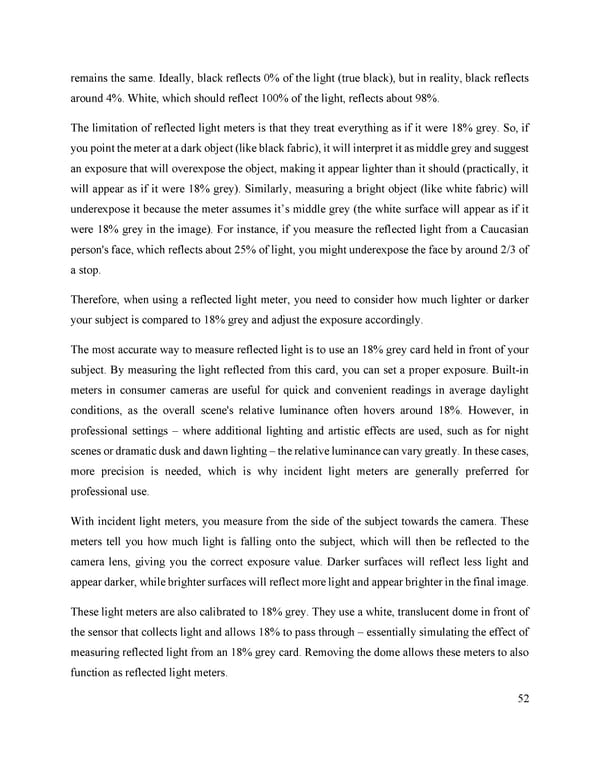remains the same. Ideally, black reflects 0% of the light (true black), but in reality, black reflects around 4%. White, which should reflect 100% of the light, reflects about 98%. The limitation of reflected light meters is that they treat everything as if it were 18% grey. So, if you point the meter at a dark object (like black fabric), it will interpret it as middle grey and suggest an exposure that will overexpose the object, making it appear lighter than it should (practically, it will appear as if it were 18% grey). Similarly, measuring a bright object (like white fabric) will underexpose it because the meter assumes it’s middle grey (the white surface will appear as if it were 18% grey in the image). For instance, if you measure the reflected light from a Caucasian person's face, which reflects about 25% of light, you might underexpose the face by around 2/3 of a stop. Therefore, when using a reflected light meter, you need to consider how much lighter or darker your subject is compared to 18% grey and adjust the exposure accordingly. The most accurate way to measure reflected light is to use an 18% grey card held in front of your subject. By measuring the light reflected from this card, you can set a proper exposure. Built-in meters in consumer cameras are useful for quick and convenient readings in average daylight conditions, as the overall scene's relative luminance often hovers around 18%. However, in professional settings – where additional lighting and artistic effects are used, such as for night scenes or dramatic dusk and dawn lighting – the relative luminance can vary greatly. In these cases, more precision is needed, which is why incident light meters are generally preferred for professional use. With incident light meters, you measure from the side of the subject towards the camera. These meters tell you how much light is falling onto the subject, which will then be reflected to the camera lens, giving you the correct exposure value. Darker surfaces will reflect less light and appear darker, while brighter surfaces will reflect more light and appear brighter in the final image. These light meters are also calibrated to 18% grey. They use a white, translucent dome in front of the sensor that collects light and allows 18% to pass through – essentially simulating the effect of measuring reflected light from an 18% grey card. Removing the dome allows these meters to also function as reflected light meters. 52
 Lost Analogue: Exploring Film, Music, and Interdisciplinary Methods in Education Page 52 Page 54
Lost Analogue: Exploring Film, Music, and Interdisciplinary Methods in Education Page 52 Page 54